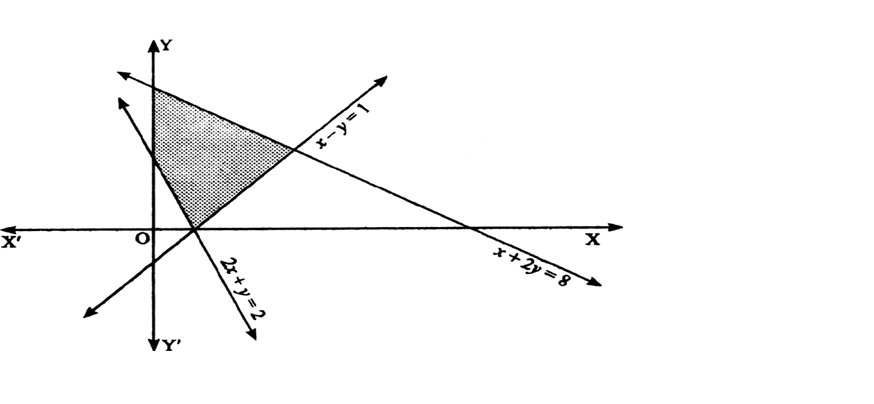 Long Answer Type
Long Answer Type
Consider the line 2x + y = 2. Clearly, the shaded portion and the origin are on the opposite sides of the graph. So, we have its inequality as:
¬† ¬† ¬† ¬† ¬† ¬† ¬† ¬† ¬† ¬† ¬† ¬† ¬†![]() ¬† ¬† ¬† ¬† ¬† ¬† ¬† ¬† ¬† ¬† ¬† ¬† ¬† ¬† ¬† ¬† ¬† ¬† ¬† ¬† ¬† ¬† ¬† [‚ąĶ 2(0) + 0 ‚Č• 2 is not true]
¬† ¬† ¬† ¬† ¬† ¬† ¬† ¬† ¬† ¬† ¬† ¬† ¬† ¬† ¬† ¬† ¬† ¬† ¬† ¬† ¬† ¬† ¬† [‚ąĶ 2(0) + 0 ‚Č• 2 is not true]
Now, consider the line x + 2y = 8.
Origin and shaded region are on the same side of the line x + 2y = 8.
So, its inequality is:
¬† ¬† ¬† ¬† ¬† ¬† ¬† ¬† ¬† ¬† ¬† ¬†![]() ¬† ¬† ¬† ¬† ¬† ¬† ¬† ¬† ¬† ¬† ¬† ¬† ¬† ¬† ¬† ¬† ¬† ¬† ¬† ¬† ¬† ¬† ¬† ¬† ¬†[‚ąĶ 0 + 2(0)¬†‚ȧ 8 is true]
¬† ¬† ¬† ¬† ¬† ¬† ¬† ¬† ¬† ¬† ¬† ¬† ¬† ¬† ¬† ¬† ¬† ¬† ¬† ¬† ¬† ¬† ¬† ¬† ¬†[‚ąĶ 0 + 2(0)¬†‚ȧ 8 is true]
Finally, consider the line x - y = 1
Origin and shaded region are on the same side.
So, its inequality is:
¬† ¬† ¬† ¬† ¬† ¬† ¬† ¬† ¬† ¬† ¬† ¬†¬†![]() ¬† ¬† ¬† ¬† ¬† ¬† ¬† ¬† ¬† ¬† ¬† ¬† ¬† ¬† ¬† ¬† ¬† ¬† ¬† ¬† ¬† ¬† ¬† ¬† ¬† ¬† [‚ąĶ 0 - 0¬†‚ȧ 1 is true]
¬† ¬† ¬† ¬† ¬† ¬† ¬† ¬† ¬† ¬† ¬† ¬† ¬† ¬† ¬† ¬† ¬† ¬† ¬† ¬† ¬† ¬† ¬† ¬† ¬† ¬† [‚ąĶ 0 - 0¬†‚ȧ 1 is true]
Also, ¬† ¬† ¬† ¬† ¬† ¬† ¬† ¬† ¬† x¬†‚Č• 0 and y¬†‚Č• 0
Thus, the linear inequalities are:
2x + y¬†‚Č• 2, ¬†x + 2y¬†‚ȧ 8, x - y¬†‚ȧ 1, x¬†‚Č• 0 and y¬†‚Č• 0
Solving the following inequalities. Also represent the solutions on the number line.
3x - 2 > x + 5
 Short Answer Type
Short Answer TypeSolving the following inequalities. Also represent the solutions on the number line.
-4x + 1¬†‚ȧ 2 (1 - x)
Solve the following system of simultaneous linear inequality and represent its solution on the number line.
2x + 3 < x - 1 and x + 4 > 2x - 3
Solve the following system of simultaneous linear inequality and represent its solution on the number line.
-3x + 2¬†‚Č• 0 and 2 - x < 0
